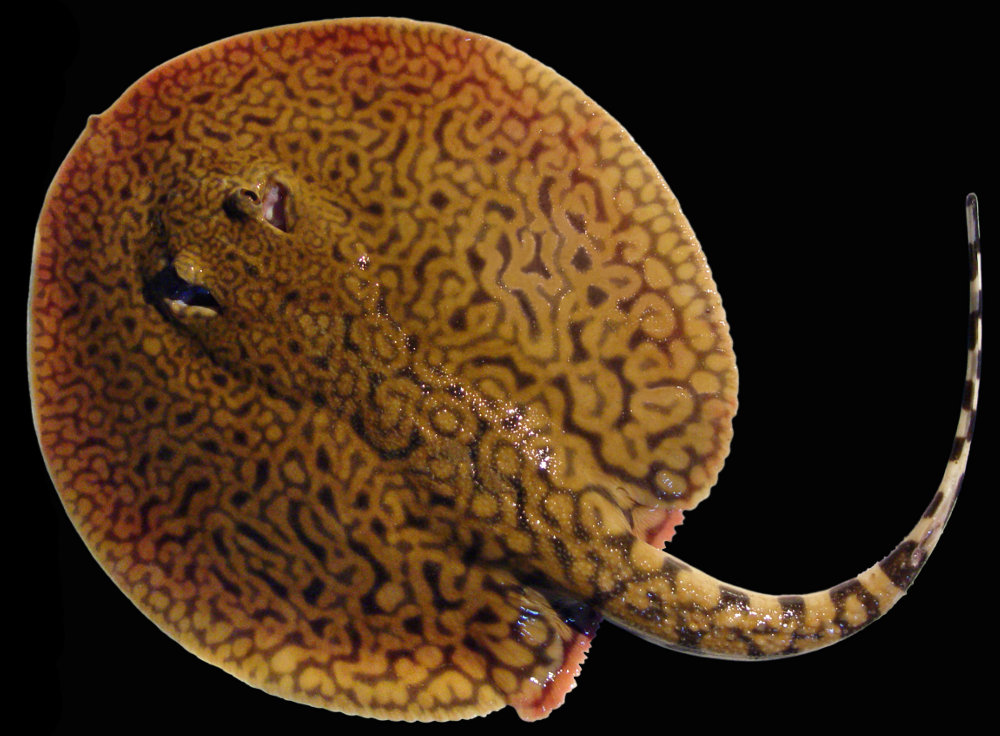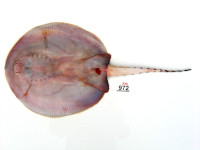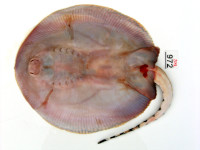Potamotrygon tigrina
Carvalho, Sabaj Perez & Lovejoy, 2011
Classification: Elasmobranchii Myliobatiformes Potamotrygonidae
Reference of the original description
Potamotrygon tigrina, a new species of freshwater stingray from the upper Amazon basin, closely related to Potamotrygon schroederi Fernandez-Yépez, 1958 (Chondrichthyes: Potamotrygonidae). Zootaxa, 2827, 1–30
Potamotrygon tigrina, a new species of freshwater stingray from the upper Amazon basin, closely related to Potamotrygon schroederi Fernandez-Yépez, 1958 (Chondrichthyes: Potamotrygonidae). Zootaxa, 2827, 1–30
Types
Potamotrygon tigrina
Holotype: ANSP: 182452; MUSM: 39978 (ex ANSP 182452); Paratype: ANSP: 191998;
Potamotrygon tigrina
Holotype: ANSP: 182452; MUSM: 39978 (ex ANSP 182452); Paratype: ANSP: 191998;
Description :
Citation: Potamotrygon tigrina Carvalho, Sabaj Perez & Lovejoy, 2011: In: Database of modern sharks, rays and chimaeras, www.shark-references.com, World Wide Web electronic publication, Version 12/2025
Please send your images of "Potamotrygon tigrina" to info@shark-references.com

Potamotrygon tigrina De Carvalho, Sabaj Perez & Lovejoy, 2011, Holotyp, © Stephen Ash Bullard and Mark Sabaj Pérez

Potamotrygon tigrina De Carvalho, Sabaj Perez & Lovejoy, 2011, Holotyp, © Stephen Ash Bullard and Mark Sabaj Pérez
Short Description
Original diadnosis of CARVALHO, SABAJ PEREZ & LOVEJOY, 2011 [13063]: A species of Potamotrygon diagnosed by its unique dorsal color pattern, composed of a light to dark brown or blackish background color, with a tan, bright yellow or orange irregular, highly curved and convoluted vermiculate pattern over entire disc and base of tail region, extending posteriorly to about one-half of tail length (to close to level of caudal stings). Potamotrygon tigrina, n. sp., is further distinguished from all other species of Pota-motrygon, except P. schroederi, by presenting the distal half of tail, from about caudal sting origin, with a sharply contrasted pattern of five to six solid dark brown to black bars and uniformly cream colored interspaces of more or less equal width. It is further differentiated from congeners, except P. schroederi, P. orbignyi, P. humerosa Garman, 1913, P. histrix (Müller & Henle, 1834) and P. marinae Deynat, 2006, by presenting a single developed angular cartilage that is about one-fourth hyomandibula length (as opposed to two developed angulars of similar size, or a single developed but very elongated angular close to one-half hyomandibular length in other congeners). Further-more, in P. tigrina, n. sp. (and P. schroederi), dorsal tail spines usually occur in two irregular, low, undefined rows which originate relatively far back on tail, at level more or less of disc apices, with spines relatively well spaced apart (congeners usually with a single or multiple row of dorsal tail spines, usually in well defined rows, with rela-tively taller tail spines that are more close packed, originating more anteriorly on dorsal tail region at tail base).
Original diadnosis of CARVALHO, SABAJ PEREZ & LOVEJOY, 2011 [13063]: A species of Potamotrygon diagnosed by its unique dorsal color pattern, composed of a light to dark brown or blackish background color, with a tan, bright yellow or orange irregular, highly curved and convoluted vermiculate pattern over entire disc and base of tail region, extending posteriorly to about one-half of tail length (to close to level of caudal stings). Potamotrygon tigrina, n. sp., is further distinguished from all other species of Pota-motrygon, except P. schroederi, by presenting the distal half of tail, from about caudal sting origin, with a sharply contrasted pattern of five to six solid dark brown to black bars and uniformly cream colored interspaces of more or less equal width. It is further differentiated from congeners, except P. schroederi, P. orbignyi, P. humerosa Garman, 1913, P. histrix (Müller & Henle, 1834) and P. marinae Deynat, 2006, by presenting a single developed angular cartilage that is about one-fourth hyomandibula length (as opposed to two developed angulars of similar size, or a single developed but very elongated angular close to one-half hyomandibular length in other congeners). Further-more, in P. tigrina, n. sp. (and P. schroederi), dorsal tail spines usually occur in two irregular, low, undefined rows which originate relatively far back on tail, at level more or less of disc apices, with spines relatively well spaced apart (congeners usually with a single or multiple row of dorsal tail spines, usually in well defined rows, with rela-tively taller tail spines that are more close packed, originating more anteriorly on dorsal tail region at tail base).
Biology
Tropical
Tropical
Habitat
Benthopelagic; freshwater
Benthopelagic; freshwater
Remarks
shark-references Species-ID=11013; CITES: (see: Protected Species for more details) Convention on International Trade in Endangered Speciesof Wild Fauna and Flora annex: III; Council Regulation 2017/160 annex: C
shark-references Species-ID=11013; CITES: (see: Protected Species for more details) Convention on International Trade in Endangered Speciesof Wild Fauna and Flora annex: III; Council Regulation 2017/160 annex: C





















